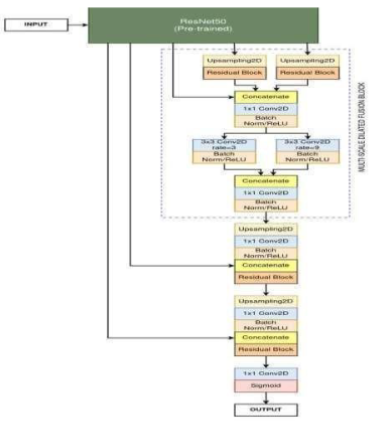MSDFN (Multi – Scale Dilated Fusion Network) for Automatic Instrument Segmentation
Keywords:
UNet, MSDFNet, medical image segmentation, Deep learning, multiscale dilated convolutionAbstract
With the recent advancements in the field of semantic segmentation, an encoderdecoder approach like U-Net are most widely used to solve biomedical image segmentation tasks. To improve upon the existing U-Net, we proposed a novel architecture called Multi-Scale Dilated Fusion Network (MSDFNet). In this work, we have used the pre-trained ResNet50 as the encoder, which had already learned features that can be used by the decoder to generate the binary mask. In addition, we had used skip-connections to facilitate the transfer of features from the encoder to the decoder directly. Some of these features are lost due to the depth of the network. The decoder consists of a Multi-Scale Dilated Fusion block, as the main components of the decoder, where we fused the multi-scale features and then apply some dilated convolution upon them. We have trained both the UNet and the proposed architecture on the Ksavir-Instrument dataset, where the proposed architecture has a 3.701 % gain in the F1 score and 4.376 % in the Jaccard. These results show the improvement over the existing U-Net model.
Downloads
References
J. D. Wright, Robotic-assisted surgery: balancing evidence and implementation, Jama 318 (16) (2017) 1545–1547.
D. Jha, S. Ali, K. Emanuelsen, S. A. Hicks, V. Thambawita, E. Garcia-Ceja, M. A. Riegler, T. de Lange, P. T. Schmidt, H. D. Johansen, et al., Kvasirinstrument: Diagnostic and therapeutic tool segmentation dataset in gastrointestinal endoscopy, in: International Conference on Multimedia Modeling, Springer, 2021, pp. 218–229.
Kumari, S. S. ., and K. S. . Rani. “Big Data Classification of Ultrasound Doppler Scan Images Using a Decision Tree Classifier Based on Maximally Stable Region Feature Points”. International Journal on Recent and Innovation Trends in Computing and Communication, vol. 10, no. 8, Aug. 2022, pp. 76-87, doi:10.17762/ijritcc.v10i8.5679.
A. A. Shvets, A. Rakhlin, A. A. Kalinin, V. I. Iglovikov, Automatic instru-ment segmentation in robot-assisted surgery using deep learning, in: 2018 17th IEEE International Conference on Machine Learning and Applications (ICMLA), IEEE, 2018, pp. 624–628.
K. He, G. Gkioxari, P. Doll´ar, R. Girshick, Mask r-cnn, in: Proceedings of the IEEE international conference on computer vision, 2017, pp. 2961–2969.
V. Balasubramanian, R. Kumar, S. J. Kamireddi, R. Sathish, D. Sheet, Semantic segmentation, detection and localisation of mucosal lesions from gastrointestinal endoscopic images using sumnet., in: EndoCV@ ISBI, 2020, pp. 82–83.
O. Ronneberger, P. Fischer, T. Brox, U-net: Convolutional networks for biomedical image segmentation, in: International Conference on Medical image computing and computer-assisted intervention, Springer, 2015, pp. 234–241.
Ghazaly, N. M. . (2022). Data Catalogue Approaches, Implementation and Adoption: A Study of Purpose of Data Catalogue. International Journal on Future Revolution in Computer Science &Amp; Communication Engineering, 8(1), 01–04. https://doi.org/10.17762/ijfrcsce.v8i1.2063
A. C¸inar, M. Yildirim, Detection of tumors on brain mri images using the 190 hybrid convolutional neural network architecture, Medical hypotheses 139 (2020) 109684.
X. Xiao, S. Lian, Z. Luo, S. Li, Weighted res-unet for high-quality retina vessel segmentation, in: 2018 9th international conference on information technology in medicine and education (ITME), IEEE, 2018, pp. 327–331.
Z. Cai, N. Vasconcelos, Cascade r-cnn: Delving into high quality object detection, in: Proceedings of the IEEE conference on computer vision and pattern recognition, 2018, pp. 6154–6162.
H. Oh, M. Lee, H. Kim, J. Paik, Metadata extraction using deeplab v3 and probabilistic latent semantic analysis for intelligent visual surveillance systems, in: 2020 IEEE International Conference on Consumer Electronics (ICCE), IEEE, 2020, pp. 1–2.
Kabisha, M. S., Rahim, K. A., Khaliluzzaman, M., & Khan, S. I. (2022). Face and Hand Gesture Recognition Based Person Identification System using Convolutional Neural Network. International Journal of Intelligent Systems and Applications in Engineering, 10(1), 105–115. https://doi.org/10.18201/ijisae.2022.273
J. Tang, J. Li, X. Xu, Segnet-based gland segmentation from colon cancer histology images, in: 2018 33rd Youth Academic Annual Conference of Chinese Association of Automation (YAC), IEEE, 2018, pp. 1078–1082.
N. K. Tomar, D. Jha, S. Ali, H. D. Johansen, D. Johansen, M. A. Riegler, P. Halvorsen, Ddanet: Dual decoder attention network for automatic polyp segmentation, arXiv preprint arXiv:2012.15245.
E. Goceri, Analysis of deep networks with residual blocks and different activation functions: classification of skin diseases, in: 2019 Ninth in-ternational conference on image processing theory, tools and applications (IPTA), IEEE, 2019, pp. 1–6.
M. J. Traum, J. Fiorentine. (2021). Rapid Evaluation On-Line Assessment of Student Learning Gains for Just-In-Time Course Modification. Journal of Online Engineering Education, 12(1), 06–13. Retrieved from http://onlineengineeringeducation.com/index.php/joee/article/view/45
Bodenstedt, S., Allan, M., Agustinos, A., Du, X., Garcia-Peraza-Herrera, L., Kenngott, H., Kurmann, T., M¨uller-Stich, B., Ourselin, S., Pakhomov, D., et al.: Comparative evaluation of instrument segmentation and tracking methods in minimally invasive surgery. arXiv preprint arXiv:1805.02475 (2018)
Allan, M., et al.: 2017 robotic instrument segmentation challenge. arXiv preprint arXiv:1902.06426 (2019)
Allan, M., Azizian, M.: Robotic scene segmentation sub-challenge. arXiv preprint arXiv:1902.06426 (2019)
Ross, T., et al.: Robust medical instrument segmentation challenge 2019. arXiv preprint arXiv:2003.10299 (2020)

Downloads
Published
How to Cite
Issue
Section
License
Copyright (c) 2022 Wangkheirakpam Reema Devi, Sudipta Roy, Khelchandra Thongam, Chiranjiv Chingangbam

This work is licensed under a Creative Commons Attribution-ShareAlike 4.0 International License.
All papers should be submitted electronically. All submitted manuscripts must be original work that is not under submission at another journal or under consideration for publication in another form, such as a monograph or chapter of a book. Authors of submitted papers are obligated not to submit their paper for publication elsewhere until an editorial decision is rendered on their submission. Further, authors of accepted papers are prohibited from publishing the results in other publications that appear before the paper is published in the Journal unless they receive approval for doing so from the Editor-In-Chief.
IJISAE open access articles are licensed under a Creative Commons Attribution-ShareAlike 4.0 International License. This license lets the audience to give appropriate credit, provide a link to the license, and indicate if changes were made and if they remix, transform, or build upon the material, they must distribute contributions under the same license as the original.





